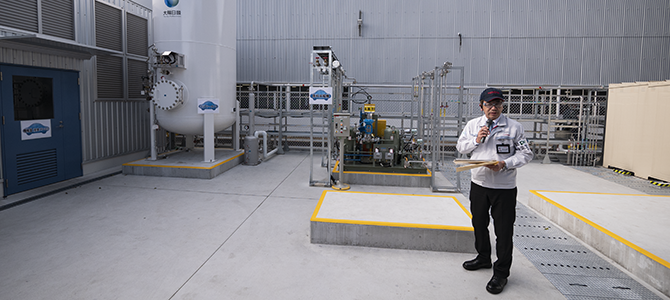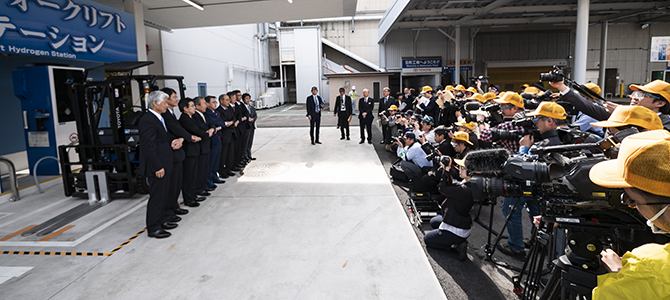Part of the sewage-to-hydrogen plant, Toyota City, Japan (c) Bertel Schmitt
Your car will eat sh*t. And that’s a good thing
The Daily Kanban, April 25, 2018 by Bertel Schmitt
Want to turn a staunch supporter of electric vehicles into a fire and invective belching monster? Easy. All you have to do is mention a certain kind of EV, namely the one powered by a hydrogen fuel cell. You’ll be immediately subjected to long tirades of how “wildly impractical, horrendously wasteful, and ridiculously expensive” the thing is. Rest assured that in the course of the discussion, the diety of electric cars, who called the technology “fool cells,” will be invoked at least three times. Meanwhile in Japan, the biggest proponent of said fuel cells, Toyota, is unperturbed, and it works towards a “hydrogen society” with the same tenacity Toyota showed way back when it was pushing its hybrid technology against all odds. Now, the industry switches to hybrid in wholesale fashion.
Today, Toyota played its trump card: Fuel cell vehicles can be powered with something that is absolutely renewable, and available in endless quantities all around the world: Human excrement.
Today in Toyota City, a coterie of celebrities, lead by Toyota’s Chairman Takeshi Uchiyamada and Aichi’s Governor Hideaki Omura, showed us how sewage sludge is turned into city gas, which is then transported through existing city gas pipelines to Toyota’s Motomachi Plant, where the gas is reformed into hydrogen. “Yes, but doing so, CO2 is created,” howls the anti-fuel-cell section. Toyota spokespeople readily conceded that CO2 is a byproduct. Then, an engineer showed me how the CO2 is piped back into the hydrogen-making process, and not into the air.
Luminaries (black suits) meet the press (yellow hats). (c) Bertel Schmitt
At the Motomachi plant, the hydrogen is used to power 22 fuel cell forklifts made by Toyota Industries. The small hydrogen plant could fit inside of an average Japanese house, and it doesn’t yet have the capacity to fill Toyota’s Mirai fuel cell car that is produced nearby in the same factory.
What we saw today is a joint project of the Aichi Prefecture, the cities of Chita and Toyota, the local power and gas companies, and Toyota. It is one of the many steps to create and fuel a “hydrogen society,” a movement that is underway all around Japan. In the Japanese cities of Yokohama and Kawasaki, just south of Tokyo, wind energy is turned into easily storable hydrogen. On Japan’s southern Fukuoka island, a whole hydrogen town has been created. Fukuoka is a pioneer of turning human waste into hydrogen, they have been at it successfully for a few years already. According to Quartz, “using wastewater is arguably the greenest way to make hydrogen.” Prodded by their government, all big Japanese automakers united to build out a network of hydrogen fuel stations...snip
...When it comes to hydrogen, Japan is not fooling around.
Full article: https://dailykanban.com/2018/04/your...-a-good-thing/
Toyota Fuel Cell Bus "Sora": https://newsroom.toyota.co.jp/en/cor.../21863761.html
Related: 2 days left for this year's Hannover Messe Hydrogen/Fuel Cell/Battery expo - the largest H2/Fuel Cell expo in the world. Live streaming all day starting at 9am CEST.
https://www.h2fc-fair.com/
Previous clips here: https://www.youtube.com/user/H2FCHannover/videos
*****************
China: The Elephant in the Hydrogen Room (The US could have led this field)
Prospects of fuel-cell electric vehicles boosted with Chinese backing.
“For the last 2–3 years, the Chinese government has put great emphasis on the roll-out of fuel cell mobility in China, shifting the public support focus slightly away from BEV to FCEV” http://energypost.eu/fuel-cell-vehic...carbon-future/
Site Information
About Us
- RonPaulForums.com is an independent grassroots outfit not officially connected to Ron Paul but dedicated to his mission. For more information see our Mission Statement.







 Reply With Quote
Reply With Quote
Connect With Us